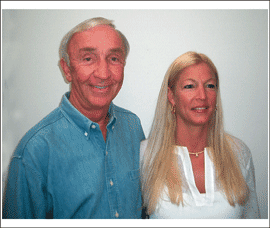A Father-Daughter Team
Bill Williams And Justine Williams-Lara
Bill M. Williams (BW), a former psychotherapist and founder of the Profitunity Trading Group, has more than 49 years of trading experience. Besides coaching traders in private tutorials, his three best-selling books -- Trading Chaos, New Trading Dimensions, and Trading Chaos: Second Edition -- have contributed to furthering his unique trading concepts. He is also well known on the speaker circuit, with a loyal following of high-level traders. He has taught seminars throughout Europe, Asia, and the US on subjects including the fractal of the Elliott wave, the money flow index, the "Wise Men," and the Profitunity "Alligator."His daughter, Justine Williams-Lara (JWL), is the president of the Profitunity Trading Group. She has been actively trading for 14 years in both the stock and commodity markets. She too has trained traders in the Profitunity methodology and teaches private tutorial classes in her office in California. Trading is her life, she says, and teaching others to trade for their freedom is what makes her continue her father's work.
John "Jay" Norris (JN), senior market strategist at Brewer Futures Group, interviewed the Williamses in person on February 23, 2008, in Southern California.

We've been teaching to trade for decades now, and one of the things that almost 100% of all new traders do is get in and out too often.
Can you tell us how you did last year trading?
BW: Last year was our best year ever. I've been trading now for a half century, and the year before last was our best up until that point, and last year was better than that. I trade only stocks now, but most of my career I'd been trading commodities. [Earlier, Williams explained how he has substituted many of the commodity markets with ETFs in the stock market. --JN]
Last year, we had several different accounts, and one account was up over 100%. [This account is his everyday account from which he takes the profits once a month and buys physical gold and interest-bearing gold certificates.] The big account was up over 40%. We started something a couple of years ago because I believe one of the things that hurts people's trading is that they get in and out too much, too quickly. So I am a trend trader and like to stay in the market as long as possible. I made the decision two years ago that on January 1, I would put on a trade and would not get out of it come hell or high water until the end of the year, and that one trade was up 40% that year, and then up 50% the year before, so by our standards we've done quite well.
I know you're quite an experienced trader and know a bit about commodities. Was there any one trade or campaign over the last few years that stands out for you?
BW: Yes. There have been quite a few. Here we are at the beginning of 2008 and the dollar is going down real fast and anything that is measured by the dollar is getting more expensive, whether it's wheat or gold or currencies. If you look at gold, for example, it has gone up tremendously in dollars. But if you look at gold in some of the foreign currencies, the chart doesn't look nearly as bullish as it does in dollars. So what we're really talking about -- and as we speak, we are in a housing slump -- is most people were thinking they were making money on their houses and now they are finding out they weren't making that much money, and the underlying structure of this market is that the dollar is going down, so anything valued in dollars is going to be more expensive.
So it's safe to say you're a trend trader?
BW: Absolutely. We've been teaching people to trade for decades now, and one of the things that almost 100% of all new traders do is they get in and out too often. We've had our best success where we've analyzed the market, tried to figure out what the long-term trend is and get in and stay in for a while, so yes I am definitely a trend trader. Now, one of the ways we get into a trade is if we see that a trend has overextended itself. We have what we call a bullish/bearish divergent bar or period where we have indicators that show us that the market has gone up too fast, so we know how to counter-trend trade that market. Often, our first entry into a market is with this countertrend signal.
What time frame do you trade?
BW: Basically, I only trade the dailies. I spent many decades looking
at the markets every moment of the day. In fact, one time my wife challenged
me to eat lunch away from the screen. For 12 years or so, she brought me
lunch every day [while I watched] the screen. If she didn't bring me my
lunch, I didn't eat. And what I found once she got me off the screen was
that the less time I spent in front of the screen, the more money I made.
...Continued in the July 2008 issue of Technical Analysis
of STOCKS & COMMODITIES
Excerpted from an article originally published in the July 2008 issue
of Technical Analysis of STOCKS & COMMODITIES magazine. All rights
reserved. © Copyright 2008, Technical Analysis, Inc.
Return to July 2008 Contents